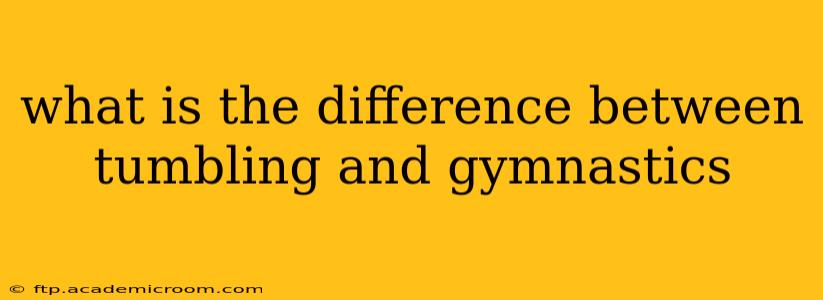What's the Difference Between Tumbling and Gymnastics?
While tumbling is a significant component of gymnastics, the two are not interchangeable. Understanding the key distinctions requires looking at the scope of each discipline. Think of it like this: tumbling is a part of gymnastics, much like a wheel is a part of a car. You can have a wheel without a car, but you can't have a car without wheels.
Gymnastics is a broad umbrella term encompassing several disciplines, including artistic gymnastics (which includes men's and women's artistic gymnastics), rhythmic gymnastics, trampoline gymnastics, and acrobatic gymnastics. Each discipline has its own specific apparatus, skills, and routines. These routines are judged based on a complex scoring system incorporating elements of difficulty, artistry, and execution.
Tumbling, on the other hand, is a more specific skill set primarily focused on a series of acrobatic movements performed on a floor, often in a straight line. These movements include forward and backward rolls, handsprings, cartwheels, back handsprings, roundoffs, back tucks, and other aerial maneuvers. While tumbling can be a competitive sport in its own right, it's also a crucial foundation for many gymnastics disciplines.
Here's a breakdown to clarify the differences further:
What are the key differences between Tumbling and Gymnastics?
- Scope: Gymnastics is a broad category encompassing multiple disciplines; tumbling is a specific skill set within those disciplines.
- Apparatus: Gymnastics utilizes various apparatus (bars, beam, vault, floor for artistic; rope, hoop, ball, clubs, ribbon for rhythmic), while tumbling is primarily performed on a floor mat.
- Routine Structure: Gymnastics routines are complex, choreographed sequences combining various skills and movements on different apparatus. Tumbling routines are typically a series of consecutive tumbling passes.
- Scoring: Gymnastics routines are judged on a comprehensive scoring system; tumbling competitions may have simpler judging criteria.
- Competition: Tumbling can be a competitive sport in itself, but it's often a part of the larger gymnastics competitions.
Is Tumbling a Part of Gymnastics?
Yes, tumbling is an integral part of many gymnastics disciplines, particularly artistic gymnastics (both men's and women's floor routines). Strong tumbling skills are essential for high scores in floor routines. Gymnasts spend considerable time perfecting their tumbling passes to add difficulty and artistry to their performances.
What are some common tumbling skills used in gymnastics?
Many tumbling skills are used across different gymnastics disciplines. Some common examples include:
- Forward Roll: A basic tumbling skill, often a starting point for learning more advanced moves.
- Backward Roll: Another fundamental skill, requiring more coordination and body awareness.
- Cartwheel: A sideways tumbling movement.
- Handspring: A more advanced skill involving a handstand and a forward roll.
- Back Handspring: An even more advanced skill involving a backward handstand and a backflip.
- Roundoff: A combination of a cartwheel and a back handspring.
- Tuck, Pike, and Straight Back Tucks: Aerial maneuvers involving flips with varying body positions.
In essence, while tumbling is a key component of gymnastics, particularly in floor routines, gymnastics is a far broader discipline encompassing multiple apparatus, skills, and competitive formats. Tumbling forms the acrobatic base for much of the dynamism and difficulty seen in gymnastics routines but is only one piece of the intricate puzzle.
